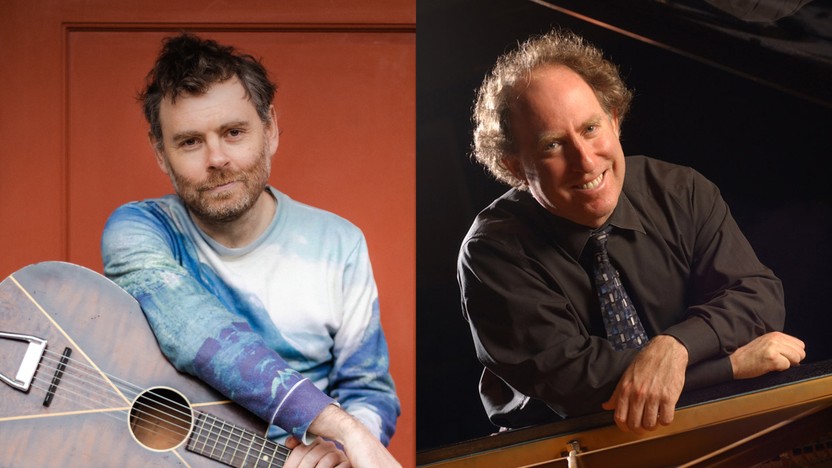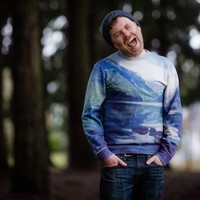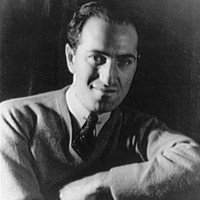Gershwin’s Rhapsody in Blue with Gabriel and Jeffrey Kahane






(Duration: 32 min)
Tucked away in the northernmost reaches of California sits the Bar 717 Ranch, which, each summer, is transformed into a sleep-away camp on 450 acres of wilderness, where, in 1967, two ten-year-old kids named Martha and Jeffrey met. Within a couple of years, they were playing gigs back in L.A. in folk rock bands with names like “Wilderness” and “The American Revelation.” They fell in love, broke up, fell in love again. By the time I was a child, my mom and dad had traded the guitars, flutes and beaded jackets for careers in clinical psychology and classical music respectively. But they remained devoted listeners of folk music. Growing up, it was routine for dad to put on a Joni Mitchell record when he took a break from practicing a concerto by Wolfgang Amadeus Mozart or Johannes Brahms. That collision of musical worlds might help to explain the creative path I’ve followed, in which songs and storytelling share the road with the Austro-German musical tradition.
That tradition comes to me through the music I heard as a child, but also through ancestry. My paternal grandmother, Hannelore, escaped Germany at the tail end of 1938, arriving in Los Angeles in early 1939 after lengthy stops in Havana and New Orleans. For her, there was an unspeakable tension between, on the one hand, her love of German music and literature, and, on the other, the horror of the Holocaust. In this piece, I ask, how does that complex set of emotions get transmitted across generations? What do we inherit, more broadly, from our forebears? And as a musician caught between two traditions, how do I bring my craft as a songwriter into the more formal setting of the concert hall?
The first movement, “Guitars in the Attic,” wrestles specifically with that last question, the challenge of bringing vernacular song into formal concert music. The two main themes begin on opposite shores: the first theme, poppy, effervescent and direct, undergoes a series of transformations that render it increasingly unrecognizable as the movement progresses. Meanwhile, a lugubrious second tune, first introduced in disguise by the French horn and accompanied by a wayward English horn, reveals itself only in the coda to be a paraphrase of a song of mine called “Where are the Arms.” That song, in turn, with its hymn-like chord progression, owes a debt to German sacred music. A feedback loop emerges: German art music informs pop song, which then gets fed back into the piano concerto.
“My Grandmother Knew Alban Berg” picks up the thread of intergenerational memory. Grandma didn’t actually know Alban Berg, but she did babysit the children of Arnold Schoenberg, another German-Jewish émigré, who, in addition to having codified the twelve-tone system of composition, was Berg’s teacher. Why make something up when the truth is equally tantalizing? I suppose it has something to do with wanting to evoke the slipperiness of memory while getting at the ways in which cultural inheritance can occur indirectly. When, shortly after college, I began to study Berg’s Piano Sonata, his music — its marriage of lyricism and austerity; its supple, pungent harmonies; the elegiac quality that suffuses nearly every bar — felt eerily familiar to me, even though I was encountering it for the first time. Had a key to this musical language been buried deep in the recesses of my mind through some kind of ancestral magic, only to be unearthed when I sat at the piano and played those prophetic chords, which, to my mind, pointed toward the tragedy that would befall Europe half a dozen years after Berg’s death?
In this central movement, the main theme is introduced by a wounded-sounding trumpet, accompanied by a bed of chromatic harmony that wouldn’t be out of place in Berg’s musical universe. By movement’s end, time has run counterclockwise, and the same tune is heard in a nocturnal, Brahmsian mode, discomfited by interjections from the woodwinds, which inhabit a different, and perhaps less guileless, temporal plane.
To close, we have a kind of fiddle-tune rondo, an unabashed celebration of childhood innocence. In March of 2020, my family and I were marooned in Portland, Oregon, as the world was brought to its knees by the coronavirus pandemic. Separated from our belongings — and thus all of our daughter’s toys, which were back in our apartment in Brooklyn — my ever resourceful partner, Emma, fashioned a “vehicle” out of an empty diaper box, on which she majusculed the words vera’s chicken-powered transit machine. (Vera had by that point developed a strong affinity for chicken and preferred to eat it in some form thrice daily.) We would push her around the floor in her transit machine, resulting in peals of laughter and squeals of delight. In this brief finale, laughter and joy are the prevailing modes, but not without a bit of mystery. I have some idea of what I have inherited from my ancestors. What I will hand down to my daughter remains, for the time being, a wondrous unknown.
Heirloom is dedicated with love, admiration, gratitude, and awe, to my father, Jeffrey Kahane.
Gabriel Kahane ©2021





(Duration: 15 min)
George Gershwin was eleven when his family first brought a piano into their apartment. Four years later, after some lessons in classical repertoire including Frédéric Chopin and Claude Debussy, Gershwin dropped out of high school and found work as a “song plugger” on Tin Pan Alley, New York’s row of music publishing firms. He began to write his own songs, signed on with a publisher and gravitated toward Broadway, finding work as a rehearsal pianist on a Jerome Kern show. Gershwin’s first Broadway production opened in 1919, and the influential performer Al Jolson added Gershwin’s Swanee to a revue that year. Jolson’s recording of Swanee sold millions of copies in 1920 and put Gershwin on the map as a top songwriter.
Gershwin reached a new milestone with the show Lady, Be Good in 1924 — it was his first full show with his brother Ira as lyricist, and it also marked his first collaboration with Fred Astaire. The same year, Gershwin made his debut as a “serious” composer with Rhapsody in Blue, a free-ranging fantasy for piano and ensemble commissioned by the popular bandleader Paul Whiteman. Gershwin only began the work five weeks before the premiere, but he soon delivered sketches to Ferde Grofé, Whiteman’s orchestrator, who prepared both the original version for Whiteman’s jazz orchestra and a later setting for full orchestra. Michael P. Atkinson created this new orchestration in 2021, supporting the piano soloist with a classical chamber orchestra.
Rhapsody in Blue borrows many elements from jazz, starting with a sultry clarinet melody that leans heavily on the flattened-seventh tone of the scale, a quintessential “blue note.” The lyrical theme that makes a grand entrance some nine minutes into the work would be gorgeous in any setting, but it is the syncopated counter-line that drives home its emotional impact. It was only the first of Gershwin’s forays into “classical” music, and he soon proved that he could also excel at orchestration and grand opera in later works including An American in Paris and Porgy and Bess, but Rhapsody in Blue stands as a perfect snapshot of a brash, confident young New Yorker who truly made the world his oyster.
Aaron Grad ©2023
Heirloom was co-commissioned for pianist Jeffrey Kahane by The Saint Paul Chamber Orchestra with support from Elizabeth and Justus Schlichting.
For digital program note only: Heirloom was co-commissioned for pianist Jeffrey Kahane by The Saint Paul Chamber Orchestra, Linda and Stuart Nelson, Kansas City Symphony, Aspen Music Festival and School (Robert Spano, Music Director), The Knights, Los Angeles Chamber Orchestra, and Oregon Symphony with support from Elizabeth and Justus Schlichting.
Get driving directions and find nearby parking.
Find dining options close to the venue.
View seating charts to find out where you'll be seating.
SPCO concerts are made possible by audience contributions.
For exclusive discounts, behind-the-scenes info, and more:
Sign up for our email club!
